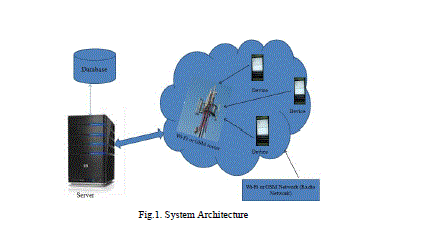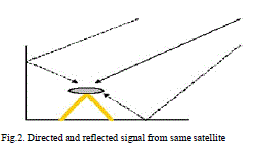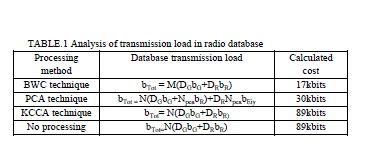ISSN ONLINE(2319-8753)PRINT(2347-6710)
ISSN ONLINE(2319-8753)PRINT(2347-6710)
Sandesha M. Kale1, Amresh Kumar2
|
| Related article at Pubmed, Scholar Google |
Visit for more related articles at International Journal of Innovative Research in Science, Engineering and Technology
Location Tracking is a very popular method of finding the location in the new era. It provides lots of applications in the market. In the recent years, the mobile service providers have deployed commercial Location- Based Services (LBS) which are a positioning method that exploits the already existing infrastructures such as cellular networks or W-LANs. The Global Positioning System (GPS) is the mostly usable positioning technique in the outdoor open environments. But it has some drawbacks such as poor performance in crowded areas and high power consumption. These drawbacks led to the development of positioning techniques based on wireless networks. In this paper, here propose localization technique by using GSM or Wi-Fi by using block based weighted clustering technique. The main aim of this technique is to reduce the computation cost and transmission load which is applied in a concatenated location-radio signal space, and attributes different weight factors to the location and radio components. The Experimental Architecture will be produced to evaluate the results and the efficiency of the BWC technique. Also, it improves the performance of standard k-means and hierarchical clustering methods.
Keywords |
| GSM or Wi-Fi system, Data compression, Android Smartphone, BWC clustering technique, three tier client server architecture. |
INTRODUCTION |
| In Today’s growing world, the development of smart phone application utilizes physical location to show the information. This is gaining significant progress in the market with extreme performance parameters [4]. Location Tracking is a very popular method of finding the location in the present era. It offers many innovative applications in the market for Mobile user. In the recent years, the mobile service providers have deployed commercial Location- Based Services (LBS). Location based service is a positioning method that exploits the already existing infrastructures such as cellular networks or W-LANs [3]. Most of these location-based applications assume GPS capabilities. Unfortunately, GPS incurs an unacceptable energy cost that can reduce the phone's battery life to less than nine hours. Alternate localization technologies, based on Wi-Fi or GSM, improve battery life at the expense of localization accuracy. This paper quantifies this important trade-off that underlies a range of emerging services. Location finding systems may be implemented by network-based and mobile-based approach. A network-based approach resides the radio database in the network and localization is done on the network area. In a mobile-based, localization is performed on the mobile side thanks to an on-board radio database. In Location finding systems, the size of the radio database is an influential factor in regards to issues such as computation load and broadcasting cost. In mobile-based systems, the computation load issued from the positioning algorithm is of large significance, since it affects directly the terminal autonomy and the CPU computing load. Concerning the latest require for energy efficient networks and the emergence of issues like green networking, fall of the computation load may be a figure of merit in location finding systems. Moreover, in a mobile-based system, the radio database and its simplified versions are transferred to the terminal through the cellular network. |
 |
| Location systems can be generally categorized into server-based and client-based architectures according to who is responsible for the positioning procedure. In the former, the mobile device reports its RSS measurement to the server and requests the estimated outcome. It provides better support for resource weak clients and a client-based architecture is an attractive result, so the privacy of users is protected. For resource-constrained handheld devices, correctness is not the only aspect of the overall system [9]. In our proposed method as shown in fig.1 we use a Cellular Radio communication system such as GSM system or Wi-Fi system to track the location instead of the GPS. |
PROBLEM DEFINITION |
| An efficient system is required to find the location of the device the Wi-Fi or GSM network is used for the network connectivity. Currently, the global positioning system is the most effective positioning technology in the outdoor open environments. How-ever, it has drawbacks such as poor performance in built-up areas and high power consumption. These drawbacks led to the development of positioning techniques based on wireless networks. a GPS uses the earth's coordinates to zero in on a location. So when looking up an address, it must convert address information into coordinates. Since addresses change, GPS devices often need to be updated frequently to keep track of the information. Updates can be expensive depending on the brand of GPS, but failing to update the database can cause inaccuracy. Sometimes even when a GPS system is properly updated, it can also be inaccurate, so depending on your GPS system completely might be problematic. Multipath is caused by GPS signals being reflected from surfaces near the GPS antenna that can either interfere with or be mistaken for the signal that follows the straight line path from the satellite. In order to get an accurate measurement from a GPS satellite, it is necessary that the signal from the GPS satellite travels directly from the satellite to the GPS antenna. If the signal has been reflected off of another surface prior to being received at the antenna, its length will be greater than was anticipated and will result in positioning error. Multipath is difficult to detect and sometimes hard to avoid. Following figure.2 shows the direction and reflection of signal in GPS system by using same satellite. |
 |
| A. Other Sources of Error in GPS |
| Signal delay caused by the ionosphere |
| Signal delay caused by the troposphere |
| Orbit errors (GPS satellite position inaccuracy) |
| Receiver noise |
PROPOSED METHODOLOGY |
A. Objectives |
| Here try to reduce the computation cost and transmission load in the mobile-based implementations to find the location and increase the efficiency by using the new Block based Weighted Clustering (BWC) Technique. On the behalf of the latest technology and try to trace the location without using Global Positioning System and saved in database using the low radio frequencies to save computation cost as well as transmission loads. Today, RSS Localization is the most widely used approach, since it does not require any additional hardware neither on the network nor on the terminal side. Note that in cellular systems, RSS measurements are performed on a broadcast channel that is not subject to the power control process (BCCH in GSM and CPICH in UMTS). Localization systems may be implemented by either a network-based or a mobile-based approach. In a network-based approach, the radio database resides in the network; hence, localization is done on the network side. In a mobile-based approach, localization is performed on the mobile side thanks to an on-board radio database. In a privacy point of view, mobile-based localization solutions are advantageous with respect to network-based methods, since in the former case, the position of the terminal is neither computed nor stocked on the network side, and hence the mobile user conserves a higher degree of privacy. In Localization systems, the size of the radio database is an influential factor in regards to issues such as computation and transmission loads. In mobile-based systems, the computation load issued from the positioning algorithm is of great importance, since it affects directly the terminal autonomy and the CPU computing load. |
B. System Architecture |
| The Wi-Fi or GSM Network is used for the Network Connectivity. This enables an application to fetch the data from Devices to send commands to database through use of middleware service where the Algorithms and system for Radio Database is defined. The database stores the required information for location and user details. Middle tier (application server) handles the data processing operations between Device and database server to provide the accurate Trace. Here the three tier client server architecture is used for the communication purpose. The three-tier client/server architecture is an evolution of the traditional two-tier model, and is receiving increased interest, particularly for large business applications. The main difference is that in a three-tier architecture, most of the functionality is separated out in a middle layer, called application servers, as shown in figure. 3. Also, each client can use several application servers, each of which in turn can work against several databases. |
 |
| The majority of three-tier applications have until now been based on relational databases and transaction processing (TP) monitors. However, the use of object-oriented technology is growing. A clustering technique for radio database compression, which takes into account both the location and the radio components of the recorded measurements. Here, define the concept of feature types in association with database records. A feature type is defined as all the stored parameters in a record that belong to the same nature. Based on this definition, a Block-based Weighted Clustering (BWC) scheme is proposed, which imposes equal weights to blocks of components belonging to the same feature type, in the clustering cost function; the weight factors associated with feature types are optimized during the clustering process. The BWC technique is used to reduce the computation cost and transmission load and it increases the efficiency and help to find the accurate location. |
EXPERIMENTAL RESULT |
| The experimental results show that reasonable location accuracy is obtained with automatic fingerprinting in indoor and outdoor environments. Here uses a BWC clustering technique to reduce transmission load as well as computation cost and shows the calculated values. The following table.1 shows the Experimental analysis of transmission load in radio database with some formulas as given in table.1. |
 |
CONCLUSION AND FUTURE WORK |
| In this paper, here studied the location tracking by using GSM and Wi-Fi. The main aim of this technique is to reduce the computation cost and transmission load by using a Block-based weighted clustering (BWC) technique. The proposed system has been implemented on a recent Android phone. In future, the model is designed flexible enough for the further modification to implement it on the larger network such as In Emergency Services to find Correct Location without using internet connection through GSM. Here, this System will save transmission Time as well as reduce Transmission Load. |
| Few Conclusions are given below: |
| 1. The Packet Size of Average Data Transmission is 17kbits for BWC(Block weighed Clustering Technique. According to Azin Arya, Paper Radio Database Compression for Accurate Energy- Efficient Localization. |
| 2. There is very less Deviation in transmitted signals in troposphere, i.e. Above 5 to 10 km above earth’s surface. And hence no atmosphere affects transmitted signals in ionosphere. |
| 3. Transmission Load is as well as time increases by Multiplier (0.2) with addition of new device. |
| 4. The Transmission is not affected by the multiple reach to the single device. As the algorithm is intact and the calculated value of each device will be same each time. |
| 5. The Average Data Transmission Time is max 4s. As Radio Transmission Required in GSM for Call Communication is less than 4 sec. (Provided the Carrier is same.) |
| 6. There is very less Deviation in transmitted signals in troposphere, i.e. Above 5 to 10 km above earth’s surface. And hence Propagation Delay is avoided. |
References |
|